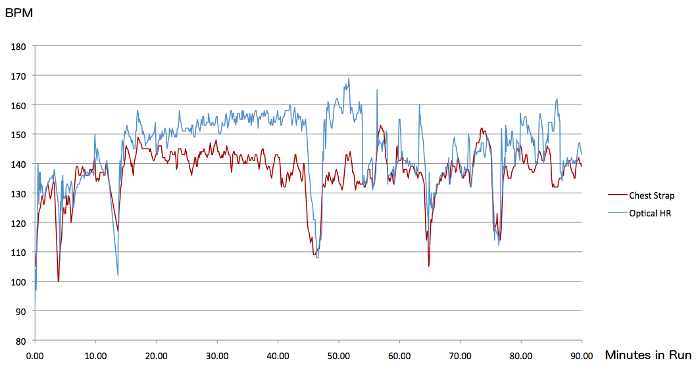I’ve been experimenting with the wrist-based optical heart rate monitor that’s built into the Garmin Forerunner 235, and wrote about it previously here. To test it further, I recently did a 90 minute easy run with the Forerunner 235 on one wrist, and a Forerunner 220 on the other, linked to a Garmin HRM3 heart rate chest strap. This particular chest strap has served me well for several years, so it provided a reliable baseline for comparison with the FR235 heart rate data.
The results weren’t good for the FR235. The graph shows the HRM3 data in red and the FR235 data in blue, and it’s obvious at a glance that there were very large discrepancies. The first 15 minutes were broadly OK, with some small deviation between the two HR measurements, but things fell apart quickly after that.
So what happened here? It looks like there were two brief spikes at 15 minutes, where my HR as measured by the chest strap reached 148. This brought it close enough to my cadence (low to mid-150s for my plodding) that the FR235’s sensor began responding to optical changes related to cadence rather than heart rate. This is a phenomenon called cadence lock, and it lasted for more than 30 minutes, even as I intentionally reduced my effort in an attempt to separate current HR further from current cadence.
Eventually I grew tired of waiting for the FR235 sensor to self-correct, so I slowed to a walk. After two minutes the HR measurements were finally back in sync. But when I resumed running, the problem immediately reappeared. What?! I tried changing my pace and stride length to see if anything would make it self-correct, but nothing helped.
In desperation, I tried tightening and loosening the FR235 strap, and moving it up and down my arm while I continued to run. At the 55 minute point, I found a spot midway up my forearm that seemed to work better, and the FR235 HR readings returned to normal.
Is it just a question of finding the magic spot on your arm, then? Sadly, it appears not. Even with the watch at the “good” spot on my arm, the FR235 HR data showed many odd spikes over the next 20 minutes, between the 55 and 75 minute marks on the graph. And then I reached the final uphill section of the run, and the FR235 HR measurements again became permanently confused while I trudged up the slope. Something about my change in stride on the uphill seems to have triggered cadence lock once again.
It’s interesting to see several places where the shape of the FR235 HR curve is correct, even where the absolute value is wrong by 10 bpm or more. Some noticeable examples of this are at 17 minutes and 52 minutes. I can imagine the watch firmware trying to make sense of two conflicting signals, one from heart rate and one from cadence, and somehow combining portions of the two rather than locking on to one or the other exclusively. It’s surely a difficult problem to solve. Unfortunately for me, the FR235 doesn’t solve it very well. Results can be very different for different people, so maybe you’ll have better luck.


8 thoughts on “Forerunner 235 Heart Rate Monitor vs Chest Strap”